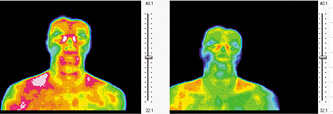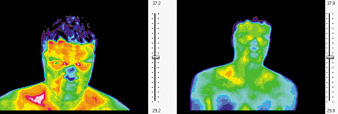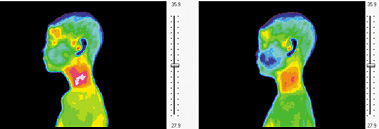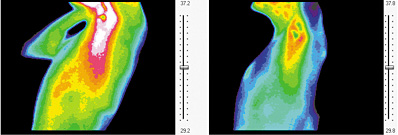According to the Centers for Disease Control & Prevention, autism affects one in 110 kids. Autism is officially called autistic spectrum disorder (ASD) and is classified as a neurodevelopmental behavior disorder. The origin of the disorder mainly resides in the brain. A small minority of experts, however, argue that ASD might be related to gastrointestinal diseases, some suggest that it may be an autoimmune disease, and some others suggest that it may be a viral disease.
According to meridian theory, there are six yang meridians that converge in the head. These meridians provide communication and coordination of brain activities with other parts of the body. These six meridians are: Bladder, Gall Bladder, Stomach, Small Intestine, Large Intestine and Triple Heater. Any disorder along the six meridians potentially could affect the development of the brain. Likewise, any disorder in the brain should affect of these meridians and cause dysfunction in parts of the body that these meridians pass through.
Can we see any evidence of malfunction of these yang meridians? We report here some preliminary results of infrared images (or thermographs), along three meridians, that we have taken of autistic children. First we take a set of thermographs, then the child drinks an 8-oz. glass of double helix water (DHW), and another set of thermographs are taken 15 minutes later. On the left of each figure is the thermograph, and on the right is the thermograph afterward. Comparing the temperature distribution of the left and the right sets of pictures give an indication of the healing effect of DHW. We can immediately see similarities in the "before" thermographs. We look for hot lines and hot spots on the surface of the body, and try to correlate them with the ST, BL, and GB meridians, and their acupoints.
Stomach Meridians. These start with acupoint ST1 just under the middle of the eye, down through the cheek, to the side of the mouth, with acupoint ST4. In Fig. 1a, the line from ST1 to ST4 is red in color. The hotter temperature along this ST meridian than the surrounding face temperature is an indication of inflammation on parts of body through which the stomach meridian passes.
At the right end of the mouth, at the position of acupoint ST4, the maximum temperature there is 39.2 C. In Fig 1b, 15 minutes later, the maximum temperature reduces to 37.8 C. The statistical fluctuation of skin temperature is about 0.1 C. So the reduction of maximum temperature is statistically significant. Similar reductions are seen at the left end of the mouth at ST4. The maximum temperature reduces from 39.4 C to 37.9 C.
The Stomach Meridian continues down from the mouth ST4, passes through the thyroid and turns left and right at the upper chest region to ST12. Our previous experiences suggest the maximum temperature around ST12 may indicate thyroid dysfunction. The maximum temperatures in the right and left parts of the upper chest cool down from 39.6 C (right ST12) and 39.4 C (left ST12) to 38.7 C and 38.8 C, respectively.

Bladder Meridian. These start from acupoints BL1, which situate at the inner extreme points of eyes, and go straight up the forehead. The maximum temperatures at the right and left BL1 before drinking DHW are 36.4 C and 36.5 C. Afterward, they reduce to 36.1 C and 36 C. Along the right and left Bladder meridian line, the maximum temperatures are 36.1 C and 36.1 C, which reduce to 35.5 C and 35.6 C. They are shown in Fig 2a and Fig 2b below.

The next places where the Bladder Meridians start to show up are at the back of the knees and thighs. This is shown in Fig 3. The maximum temperatures of the right (Fig 3a) and left (Fig 3b) back legs in the region from BL37 to BL40 are 34.6 C and 34.3 C, respectively. They reduce to 33.7 C and 33.8 C.

Gall Bladder Meridian. In Fig 4, we notice many acupoints appear as hot spots on the side of the head. We interpret the hot spot next to the eye as GB1 and the one next to the center of the ear to be GB2. The hot spot just further from the ear towards the forehead is GB3, and the hot regions on the forehead are GB15 and GB17. The maximum temperatures of GB1, GB2, GB3 and GB15 area are 34.2 C, 34.7 C, 34.7 C and 34.6 C, respectively. They reduce to 33.7 C, 34.4 C, 34.1 C and 34 C.

As Gall Bladder meridians go down from the neck, they pass the armpits area, with acupoints GB22. We notice in many subjects we study that the arm pit areas are inflamed. This may indicate inflammation of the lymphatic nodes due to overactivity of the of immune system. It may also indicate the inflammation of Gall Bladder meridians. Interpretation of thermographs is non-specific, but very useful if correlated with other symptoms. In Fig 5 the thermographs of the left arm pit are shown before and after drinking DHW.

There is clear inflammation of the three Yang meridians, which indicates dysfunction of the gastrointestinal system, which is consistent with some research workers in mainline medicine. These meridians also originate from the head, so inflammation is also a reflection of brain dysfunction of the brain.
Chinese medicine views a child as a whole. So the gastrointestinal, immune and neurological systems should be treated together. It may be done by acupuncture, which will concentrate on the hot spots along the six yang meridians. It may also be treated by herbs that reduce inflammation. Here we give an example where the inflammation along the yang meridians are reduced by drinking DHW.




